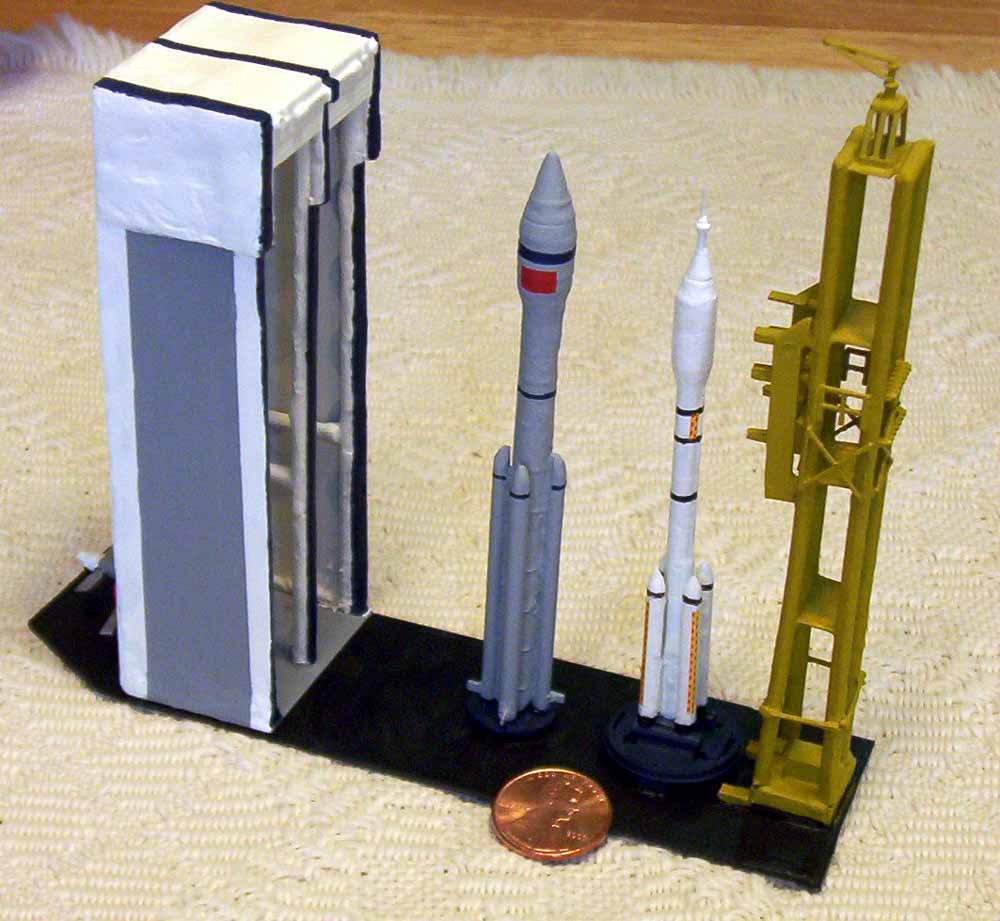 |
 |
These are two custom-made 1/700 models of modern Chinese space launch vehicles. At the pad being prepared for launch is a CZ-3B (westernized name Long March-3B). The CZ-3B is China’s most powerful, most advanced, and most sophisticated space launch vehicle currently in service. It is very similar to the CZ-3A but with four liquid-fuel strap-on boosters of the type used by the CZ-2E. This addition will nearly double the payload capacity to 5.1 tons and provide around 12 ton capacity to low earth orbit.
The CZ-3B/C was developed on the basis of the CZ-3A, but had enlarged propellant tanks, larger fairing, and four boosters strapped onto the core stage. The CZ-3B/C's boosters were identical to those of the CZ-3A. The standard fairing was 9.56 m long, 4.0 m in diameter.
The first flight of the CZ-3B took place in 1996, when China’s space program was heavily hit due to the failure of two of its three space launch missions in the year. Unfortunately the CZ-3B experienced experience an anomaly in attitude about 2 seconds after launch at Xichang Satellite Launch Centre, pitching down and yawing to the right. It augured in nose down at T+22 seconds and exploded violently, utterly destroying the launcher and its payload -- the $125-million Intelsat 708 satellite which was to be used primarily for direct broadcast satellite (DBS) services to Latin America. The accident killed 6 ground staffs, and injuring another 57.
This was the most severe accident in the history of China’s space programme, and incurred the most serious casualties. The launch was the second in a series of 10 Intelsats (the first by a CZ/Long March rocket) covered under an insurance premium of $185 million purchased by Intelsat in 1994. Premiums for the three Long March launches covered by this package had been set at 13%. The loss cost the insurers $205 million. By 28 March 1996 the Chinese investigation and analysis of the failure determined the cause to be a malfunction of the vehicle's inertial guidance system two seconds after ignition.
A new CZ-3C will fill the gap between the CZ-3A and CZ-3B by using only two strap-on boosters, giving it a GTO payload capacity of 3.7 t. So far the CZ-3C has not been launched yet.
Behind the CZ-3B is the CZ-2E(A) [westernized name Long March-2E(A)]. The CZ-2E(A) represents an extension of the existing CZ-2E with stretched strap-on boosters and an enlarge payload shroud. The booster consists of a 2-stage core vehicle with four lengthened strap-on stages, all employing UDMH and nitrogen tetroxide. The strap-on stages may each use two FY20 engines, versus the single FY20 engine used on the CZ-2E. The fairing is 5.20 m in diameter and 12.39 m long to accommodate large spacecraft. The large low Earth orbit payload of this launch vehicle indicates that it is probably intended to support the Chinese piloted spaceflight effort, possibly to launch a small space station.
Behind the assembly building is a 1/700 scale mock-up of the ShenZhou-5 spacecraft. On 15 October 2003, the ShenZhou-5 carrying China’s first astronaut Air Force Lt. Col. Yang Liwei was successfully launched from Jiuquan Satellite Launch Centre. After travelling 21 hours and 23 minutes on the earth orbit, the spaceship landed in Inner Mongolia safely, making China the third country in the world to be able to send man into space.
It is understood that China’s manned space program consists of three development phases. The first phase includes the launch of several unmanned spaceships between 1999 and 2002, followed by two manned flights by 2005. The second phase aims to achieve space docking and space walking by 2010, and eventually leads to an 8t class temporary space lab. The third phase is to establish a permanent 20t class space station by 2020. Long-term goals of China’s manned space programme might include space shuttle, large space manufactory station, and even landing on the moon.